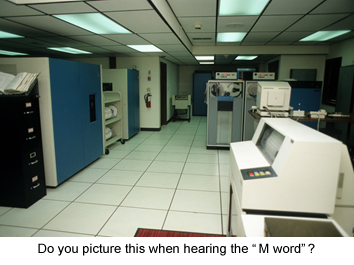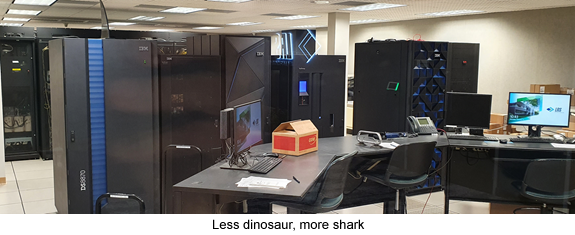Not long ago, I heard one of my newer colleagues giving an online presentation to our customers and business partners. Like a lot of our salespeople, he summed up our product offerings with the statement “LRS solutions let you deliver any document from any platform – mainframe to mobile – to any printer or other output destination.”
That middle part of his closing remark, “mainframe to mobile” caught my ear. This new employee seemed too young to have had much personal experience with mainframe computing, and due to COVID restrictions, I’m not sure he has had the opportunity to visit LRS headquarters. Like most of us, he probably knows a lot about mobile computing, but has he ever actually seen a mainframe?
Big Iron, Big Deal
As I noted in a Blog article earlier this year, the mainframe platform is anything but dead. One thing that nearly every global bank, vehicle manufacturer, government, insurance company, and airline company have in common is their reliance on “big iron.” Some reasons for this are the mainframe’s inherent scalability, legendary reliability, and proven security. In truly global companies, no one is seriously talking about the extinction of the mainframe. It’s evolved into a super server.

These legacy environments are arguably expensive to develop and maintain, but when it comes to securely managing billions of transactions per day, few other platforms can compete. And when it comes to managing the documents created by these business transactions, nothing compares to our VPS® output management solution.
In recent years, much of LRS’ marketing and development effort has revolved around our open systems, cloud, and services offerings. However, LRS is one of the few output management software providers still developing and enhancing our software solutions for the IBM z/OS platform. It sets us apart from the competition, both technically and financially, giving us the wherewithal to launch innovative solutions like LRS Internet Printing.
At this point, you may be asking yourself why you should care… especially if your organization does not, did not, and never will have applications that run on legacy mainframe hardware. Perhaps even my young colleague on the sales team has wondered this to himself.
Here goes…

First, due to the staggering numbers of transactions processed on mainframe hardware, the enterprise market has always placed a premium on the efficiency and reliability of the code that runs there. At LRS, we cut our teeth in this demanding environment, and our dedication to optimizing LRS software has carried through to every product we develop, whether running on Windows, UNIX, Linux, a virtual terminal, or a mobile device. Unlike vendors who sometimes take a “throw another server at the problem” approach, we know that true scalability comes through efficiency, not redundancy.
Second, a dedication to the “any document from any platform to any destination” approach gives customers confidence that current investments in an output management strategy will continue to pay dividends as their IT landscapes evolve over time. While your current IT environment may be largely Windows-based, mergers and acquisitions can change things in a hurry. If a newly acquired business unit relies on applications running on open systems or legacy platforms, the versatile LRS solution can accommodate this heterogenous environment. The result is a single point of control for managing all your output, regardless of document origin or format.
Finally — and perhaps most importantly — is the human factor. LRS has been working in the field of print and output management for over four decades. Over that time, we’ve built a technical organization with thousands of man-years of experience. The probability that your organization will run into an output-related problem that none of the Fortune 1000 companies have experienced is remote indeed. And if you do, LRS can summon the collective expertise of more than a hundred technicians around the world to help you address your output challenges.
When it comes to managing your company’s most important documents, we’ve got back. And your software.